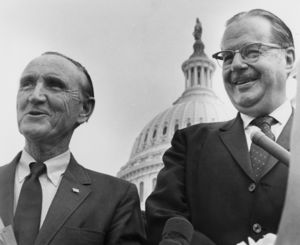
In May 1974, Pulitzer Prize-winning biographer and political historian Arthur Schlesinger, Jr., wrote a letter to Senate Majority Leader Mike Mansfield supporting a proposal to establish a Senate Historical Office. “The creation of such an Office would be of benefit,” Schlesinger wrote, “not only to historians and concerned citizens but to the Senate itself.” Schlesinger understood that the twin political crises of the 1970s—the Watergate scandal and the unpopular Vietnam War—had caused a growing number of Americans to lose faith in their institutions and to demand greater transparency from them. “If we are going to persuade the nation that Congress plays a role in the formation of national policy,” he wrote, “Congress will have to cooperate by providing the evidence for its contributions.” The next year, with the bipartisan blessing of Mansfield and Republican leader Hugh Scott, the Senate Historical Office was established on September 1, 1975.1
Tasked with overseeing the new office, Secretary of the Senate Francis Valeo articulated its mission. “Executive Branch departments and agencies have long had large historical offices and have long published or made public many of their important confidential papers,” Valeo explained in a letter to Senate appropriators justifying the creation of the new office. A Senate historical office would assist in the “organization of the Senate’s historic documentation,” serve as a “clearing house for public requests concerning historical subjects,” and “collect and preserve photographs depicting the history of the Senate.”2
Valeo hired Richard Baker to lead the new office. Baker brought a unique blend of skills and experience to the role. With degrees in history and library science, Baker had served as the Senate’s acting curator from 1969 to 1970 and then as vice president and director of research for the National Journal’s parent company. Former Washington Times staff photographer Arthur Scott filled the position of photo historian. Baker soon hired Leslie Prosterman as a research assistant and Donald Ritchie as a second historian.
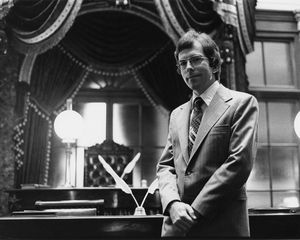
Historians and newspapers heralded the office’s creation. “On behalf of the [American Historical] Association I want you to know how pleased we are that the Senate has established this new historical office,” wrote Mack Thompson, the organization’s executive director. “Much of the Senate’s business in the past was conducted in closed committee meetings,” noted Roll Call, leaving Senate records “locked away and forgotten,” resulting in the “history of significant public policy issues [being] written from the perspective of the Executive Branch where confidential records are generally declassified and published on a systematic basis.” The New York Times predicted that there would be much interest in the Senate’s “closed-door briefings on Pearl Harbor, the Cuban missile crisis, and the missile-gap controversy of the Eisenhower administration.” Generations of reporters, historians, and political scientists would come to rely upon the non-partisan expertise provided by Senate historians.3
One of the office’s most pressing early tasks was locating and arranging for the proper preservation of the Senate’s “forgotten” records. “Most senators in 1975 had given little thought to their papers,” recalled Baker in an oral history interview in 2010. Baker’s job was to persuade senators that selecting a repository for their papers was “prudent management practice … in the interest of public access.” There was much work to be done. Baker found humid attic and dank basement storerooms in the Russell Senate Office Building filled to overflowing with committee and member papers. A recent basement flood had destroyed 30 years of irreplaceable materials. Similarly, attic spaces, where temperatures soared in the summer and the prospect of a fire was not unthinkable, were ill-suited for safely preserving records. Racing the clock, Senate historians appraised collections and helped arrange for their long-term preservation. “Our major role is advisory,” Baker wrote during those early years. “We do not intend to build our own archives … [but to facilitate] the flow of archival materials to repositories where they will receive sufficient care and exposure.”4
The tidal wave election of November 1980 brought renewed urgency to Senate historians’ work. Eighteen departing senators had only a few months to vacate their offices. Some were leaving voluntarily, while others had been unexpectedly retired by their constituents. Historical Office staff scrambled to assist departing members—including Warren Magnuson of Washington State and Jacob Javits of New York, whose combined congressional service totaled 78 years—with moving their voluminous record collections to hastily designated repositories. Soon after that election, Baker hired Karen Paul as the Senate’s first archivist. Paul would devote the next 43 years of her career to advising senators, staff, and officers on the preservation and disposition of their records, developing archival policies and practices to ensure the preservation of Senate records for future generations, and building a community of professional Senate archivists.
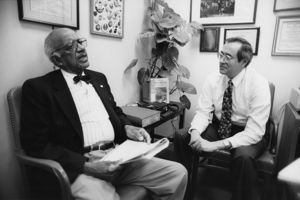
Over the past five decades, the Senate Historical Office has built partnerships and institutional capacities to aid in the preservation of congressional records for the long term. Working with congressional leadership, the Historical Office helped to establish a separate division within the National Archives to serve as the official repository for congressional committee records in 1985—named the Center for Legislative Archives in 1988. In 1990 the Office co-founded the Advisory Committee on the Records of Congress to explore issues pertinent to congressional records management, and it co-created the Association of Centers for the Study of Congress in 2004, a nationwide consortium of congressional records repositories and research institutes. Today, Senate archivists continue to advance the Senate’s historical record by shaping how its documentation is preserved and accessed. They have developed and updated official records management policies and have pioneered digital preservation practices, creating workflows for archiving email, social media, and audiovisual records in line with national standards. Senate archivists also provide specialized staff training that equips members and support offices, as well as committees, to manage both paper and electronic records with confidence. The Historical Office also administers the Secretary of the Senate’s Preservation Partnership Grants that strengthen the capacity of repositories across the country to process and provide access to senators’ papers, broadening the range of materials available for research. This work safeguards the very documentation on which Senate history rests.
While preserved official records illuminate aspects of Senate history, they rarely tell the full story of an institution’s evolution. From the Historical Office’s earliest days, Senate historians have sought to document the social, cultural, and technological changes within the Senate with the Senate Oral History Project. Don Ritchie developed and led the project, with a mission to record and preserve the experiences of a diverse group of personalities—both staff and senators—who witnessed events firsthand and offer a unique perspective on Senate history. Interviews help to explain, for example, women’s evolving role in the Senate, and the impact of changing technology on the institution. There were no women senators serving in 1975, while 26 women serve in the 119th Congress. Only one senator’s office used a computer in 1975 to manage constituent services, while today, emails, the internet, and social media are ubiquitous Senate-wide. Collectively, these oral histories help to promote a fuller and richer understanding of the institution’s evolution and of its role in governing the nation.
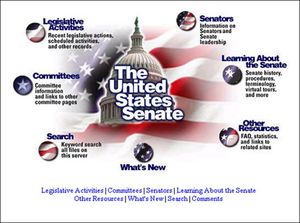
The advent of the internet in the mid-1990s provided new opportunities to share Senate history with a broader range of audiences. When Betty Koed joined the team as assistant historian in 1998, she began populating the (then relatively) new Senate website with oral history transcripts and historical information. Today, the Historical Office has integrated a wealth of Senate history across Senate.gov, created a Senate Stories blog, and developed online exhibits including “The Civil War: The Senate’s Story,”“The Civil Rights Act of 1964,”“States in the Senate,” and “Women of the Senate.”
Since its founding, the Historical Office has developed and maintained a reputation among senators, staff, journalists, scholars, and the general public for providing fact-based, non-partisan information about the institution’s history. Its staff manage dozens of statistical lists and maintain information about senators and vice presidents in the online Biographical Directory of the United States Congress. Historians lead custom tours for members and staff and deliver history “minutes”—brief Senate stories about a subject of their choosing—at the party conference luncheons and for the Senate spouses. They offer brown bag lunch talks, deliver committee and state legacy briefings, and host an annual Constitution Day event. Historical Office staff have provided background and research support for dozens of books on the Senate, as well as historic events such as inaugural ceremonies, three presidential impeachment trials, and the 1987 congressional session convened in Philadelphia to commemorate the bicentennial of the Great Compromise which paved the way for the signing of the U.S. Constitution.
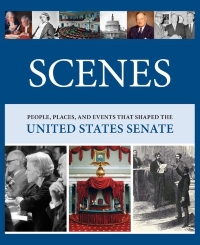
In addition to these varied services, Senate historians have supported a number of projects for members and committees, including Senator Robert C. Byrd’s four-volume The Senate, 1789–1989; Senator Robert Dole’s Historical Almanac of the United States Senate; the executive sessions of the Committees on Homeland Security and Governmental Affairs (1953) and Foreign Relations (1947–1968); and Senator Mark Hatfield’s Vice Presidents of the United States, 1789–1993. The Historical Office team has authored print publications including the United States Senate Election, Expulsion and Censure Cases, 1793–1990 (1995); 200 Notable Days: Senate Stories 1787–2002 (2006); Scenes: People, Places, and Events That Shaped the United States Senate (2022); and Pro Tem: Presidents Pro Tempore of the United States Senate (2024). The Office has helped to document party histories by editing the minutes of the Republican and Democratic Conferences and producing A History of the United States Senate Republican Policy Committee, 1947–1997. These publications have been illustrated, in part, with images drawn from the Historical Office’s rich photo collection.
During the past half-century, the Historical Office has adapted to meet the needs of an ever-evolving institution while continuing to provide the services first articulated by Secretary of the Senate Valeo in 1975. Today, its staff of 12 historians and archivists are dedicated to preserving and promoting Senate history for the next 50 years.
Notes